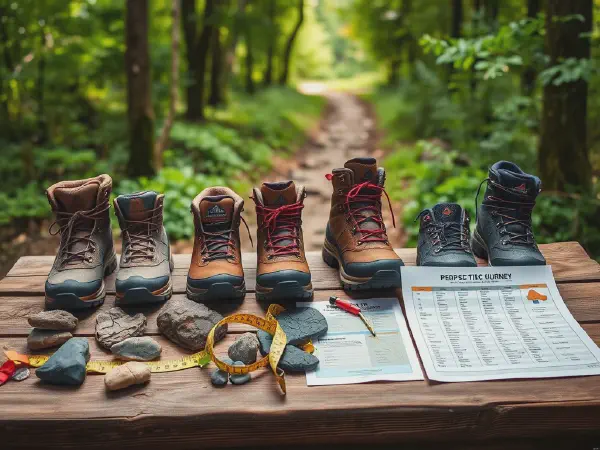Step-by-Step Guide: Choosing Perfect Hiking Boots

The Ultimate Guide to Hiking Boots
Hiking boots are essential for outdoor enthusiasts who want to explore trails while ensuring comfort and protection for their feet. These boots are designed to provide the necessary support and traction needed for various terrains, allowing hikers to enjoy their adventures without discomfort. Investing in the right pair of hiking boots can make a significant difference in your experience, whether you're embarking on a short day hike or a multi-day backpacking trip.
When it comes to hiking boots, understanding the different types available is crucial. Each type is designed for specific hiking activities and terrains. Day hiking boots are perfect for short trails and casual hikes, while backpacking boots are built to handle heavy loads and longer excursions. For wet environments, waterproof boots provide the necessary protection, and trail runners offer a lightweight alternative for shorter hikes.
In addition to knowing the types of hiking boots, it is imperative to consider key features when making a purchase. Fit is essential, as a proper size ensures comfort during hikes. The material of the boots can also impact durability and weight, with leather offering sturdiness while synthetic materials provide breathability. Weight is another factor that affects your hiking experience, as lighter boots are generally easier to wear over long distances, but heavier boots might provide more support.
Traction is another critical feature to pay attention to when choosing hiking boots. The type of sole impacts grip on different terrains; aggressive treads are suitable for rocky paths, while smoother soles may be better for well-maintained trails. Additionally, proper maintenance of hiking boots is vital for their longevity. Regular cleaning, waterproofing, and proper storage can extend the life of your boots, while knowing when to repair or replace them is also important.
In the world of hiking boots, several brands stand out due to their quality and performance. Customer reviews provide valuable insights into the real-world performance of various models, helping prospective buyers make informed choices. Understanding the differences between budget and premium options can guide you to find the best value for your needs. Lastly, outdoor gear testing can offer performance insights that may not be available through marketing materials alone.
Types of Hiking Boots
Day hiking boots are best for short trails. They typically offer a lightweight design and are made from breathable materials, making them suitable for casual day hikes. These boots usually feature good traction and support without being too heavy, allowing hikers to move comfortably over less challenging terrain.
Backpacking boots are designed for heavy loads and longer hikes. They provide additional ankle support, which is essential when carrying a backpack full of gear for multiple days. These boots tend to be more rugged, focusing on stability and durability for serious outdoor adventures.
Waterproof boots are ideal for wet conditions as they keep your feet dry and comfortable. Whether you're hiking through muddy trails, streams, or rain, these boots are designed with waterproof membranes that prevent moisture from entering while still allowing your feet to breathe.
Trail runners are lightweight and fast, making them perfect for shorter hikes. Designed for speed and agility, these shoes are suitable for well-maintained trails where heavy-duty support isn’t required. They provide good traction and are more breathable than traditional hiking boots, making them a favorite among fast hikers.
Key Features to Consider
Fit is one of the most critical factors when selecting hiking boots. Ensuring that you have the correct size and a comfortable fit is essential for preventing blisters and discomfort during your hike. It's important to consider factors such as width, arch support, and whether you plan to wear thick socks when trying on boots.
The material of hiking boots can significantly influence their performance and lifespan. Leather boots are durable and offer excellent protection but can be heavy and less breathable. Synthetic materials, while lighter and more breathable, may not provide the same level of durability. The choice between these materials often comes down to personal preference and the type of hiking you plan to do.
Weight plays a crucial role in your hiking experience. Lightweight boots reduce fatigue, allowing you to hike longer distances with less effort. However, heavier boots may offer more support and protection on rugged terrain, making it important to find a balance that suits your hiking needs.
Traction is vital for safe hiking, and different soles offer various levels of grip. Look for boots with aggressive treads for rocky or uneven terrain and those with flatter soles for smoother trails. Consider the type of hiking you’ll be doing to choose the right traction for your footwear.
Hiking Boot Maintenance
Cleaning your hiking boots after each use is crucial for their longevity. Dirt, mud, and moisture can break down materials over time, leading to wear and tear. Use a soft brush to remove dirt and a damp cloth to wipe down surfaces. Regularly checking for damage is also important, as early detection can lead to easier repairs.
Waterproofing your hiking boots ensures that they remain effective during wet hikes. Depending on the material, you can use sprays or waxes to create a protective barrier against water. Reapplying waterproofing treatments as needed will help maintain dryness during your adventures.
Proper storage of hiking boots can significantly extend their life. Store them in a cool, dry place away from direct sunlight to prevent material degradation. Consider using boot trees or crumpled paper to help maintain their shape, and always ensure they are clean before storing them.
Knowing when to fix and when to replace your hiking boots is essential for maintaining optimal performance. Minor repairs like fixing laces or re-gluing soles can prolong the life of your boots, but major structural damage or wear and tear may mean it’s time for a new pair.
Brands and Reviews
When it comes to hiking boots, several brands have gained a reputation for quality and performance. Notable names include Merrell, Salomon, and Columbia, each offering a wide variety of styles for different hiking needs. Researching these brands can help you find the right fit and features for your hiking adventures.
Customer reviews are a valuable resource for understanding how different models perform in real-world conditions. Hikers often share their insights about comfort, durability, and support, helping others make better-informed decisions when selecting hiking boots.
Budget vs. premium hiking boots is an important consideration for many buyers. While premium brands often offer higher quality materials and advanced features, budget options can still provide adequate performance for casual hikers. Determine your needs and how much you are willing to invest to find the right pair for you.
Outdoor gear testing by experts and enthusiasts alike can reveal the performance of hiking boots in various conditions. These tests often assess factors such as comfort, traction, and durability, providing a comprehensive understanding of how a model handles real hiking scenarios.
Choosing Hiking Boots for Different Terrains
When hiking on rocky terrain, it’s essential to choose boots that offer ample support and cushioning. Look for boots with thicker soles and reinforced toe caps to protect your feet from sharp rocks and uneven surfaces. Sturdy ankle support is also recommended to prevent injuries.
In muddy and slushy conditions, having the right waterproof boots is crucial. Ensure the boots you choose have effective waterproof membranes and treads that provide grip to avoid slipping. Opt for high-top designs if you expect to encounter deep water or mud.
For snow and ice, insulated hiking boots are necessary to keep your feet warm and dry. Look for boots with thermal linings and waterproof features to combat cold and wet conditions. Additionally, consider models with specific traction systems for ice to prevent slipping.
In sandy and desert environments, breathable and lightweight footwear is best. Look for boots that offer good ventilation and drainage while still providing protective features. Choosing materials that dry quickly is also essential for comfort in hot climates.
